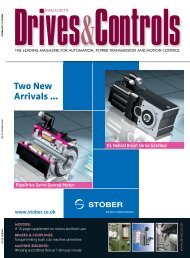New Danfoss VLT® Decentral Drive E cient, reliable and powerful
New Danfoss VLT® Decentral Drive E cient, reliable and powerful
New Danfoss VLT® Decentral Drive E cient, reliable and powerful
You also want an ePaper? Increase the reach of your titles
YUMPU automatically turns print PDFs into web optimized ePapers that Google loves.
PLCs AND HMIs<br />
method <strong>and</strong> the sealing arrangements<br />
for dust <strong>and</strong> fluids.<br />
From this you can gauge the likely<br />
functionality. A quick check of the<br />
headline software features does the rest.<br />
For example, does it offer scalable<br />
graphics (you don’t want to have to<br />
develop separately for each size of<br />
panel)? Also, how does the alarm<br />
h<strong>and</strong>ling interface with external systems,<br />
<strong>and</strong> can the panel generate SMS alerts<br />
directly without needing another<br />
program (as would be the case for a PCbased<br />
alternative)? Is the HMI program<br />
backed-up to non-volatile memory <strong>and</strong><br />
can the memory be exp<strong>and</strong>ed via<br />
memory card slots? The ability to use<br />
one HMI panel to display another’s<br />
content can also be an advantage. The<br />
list goes on, but attractive <strong>and</strong> functional<br />
features are exposed in this way.<br />
The remaining item on the checklist is<br />
connectivity to controllers. Extensive<br />
connections are needed for a st<strong>and</strong>ard<br />
hardware <strong>and</strong> software HMI system that<br />
can be deployed across a whole site <strong>and</strong><br />
for machine-builders who may have<br />
different controllers on different<br />
machines, but want to benefit from a<br />
st<strong>and</strong>ard operator display.<br />
Compact Flash-slot<br />
Can – or should – you ab<strong>and</strong>on PCbased<br />
Scada <strong>and</strong> move to CE-based<br />
HMI? Well, you would save a lot of<br />
money but, as ever, you need to take a<br />
balanced view. Modern CE-based HMIs<br />
do not have the same compromises <strong>and</strong><br />
difficulties that you might remember<br />
from earlier generations. Combined<br />
hardware <strong>and</strong> software systems will<br />
probably offer useful extra functions<br />
(such as SMS alerting) compared to<br />
RS422/485 Expansion port Internal Compact Flash-slot<br />
USB Host<br />
Ethernet<br />
A peek around the back of an HMI panel reveals its connections <strong>and</strong> other design features<br />
RS232<br />
piecemeal supplies.<br />
The control room <strong>and</strong> the line<br />
controller are the domains of Scada <strong>and</strong><br />
DCS solutions. But “out there” <strong>and</strong><br />
“down there” you need the functions,<br />
robustness <strong>and</strong> attractive pricing of an<br />
all-in-one CE-based HMI panel. This<br />
could be the right time for you to reevaluate<br />
your view of CE-based HMIs –<br />
there is much to be gained, <strong>and</strong> nothing<br />
D&C<br />
to be lost.<br />
Dual PLCs ensure a smooth lift for aircraft passengers<br />
An Italian company called Oxley specialises in manufacturing aerial<br />
platform systems, including vehicles used to transfer people with<br />
restricted mobility to <strong>and</strong> from passenger aircraft.<br />
Traditionally these vehicles have been based on diesel-engined trucks<br />
which have been costly to buy <strong>and</strong> maintain. Since 2005, Oxley has<br />
been working on an alternative electrically-powered design which is<br />
smaller <strong>and</strong> cheaper to operate <strong>and</strong> has been designed to comply with<br />
new European airport <strong>and</strong> environmental regulations.<br />
A key requirement was the ability to operate the lifting system both<br />
from the ground <strong>and</strong> from the platform in the raised position, <strong>and</strong> to<br />
provide the operator with full information on this process.<br />
Initially, Oxley produced a platform using relay-based electronics but<br />
the authorities rejected this approach, saying that it did not comply<br />
with stringent airport st<strong>and</strong>ards. Oxley therefore decided to fit the<br />
mechanical components, fully tested, to the vehicle <strong>and</strong> to adopt<br />
programmable industrial controls.<br />
The latest vehicle – known as the <strong>New</strong>Ox906Air – is controlled by two<br />
Rockwell Automation Micrologix 1100 PLCs. One PLC is installed on the<br />
platform which carries the passenger <strong>and</strong> operator. The second is<br />
located within the electric motor bay in the lower section of the<br />
vehicle. The PLCs communicate with each other using the DH485<br />
protocol, allowing communication via three coiled cables which avoid<br />
problems of cable movement <strong>and</strong> wear.<br />
The use of two PLCs guarantees redundancy of the control systems<br />
responsible for maintaining the platform in the correct horizontal<br />
attitude, <strong>and</strong> prevents any unexpected movement <strong>and</strong> the risk of<br />
collision or crushing when docking with the aircraft. Operators can<br />
check the operating parameters via a Rockwell PanelView C300 control<br />
panel which also provides first-level diagnostics for detecting faults.<br />
Maintenance personnel can monitor the control system remotely via<br />
Uplifting: Oxley’s air passenger transport vehicle uses a pair of PLCs to<br />
provide redundant control <strong>and</strong> to allow operation from two locations<br />
Ethernet, thus reducing maintenance times <strong>and</strong> costs in the event of<br />
any problems.<br />
The electrically-propelled platform is said to be quick <strong>and</strong> simple to<br />
operate. It is fitted with all of the safety systems needed to embark <strong>and</strong><br />
disembark passengers without risk to their safety or damage to the<br />
aircraft.<br />
40 November/December 2010 www.drives.co.uk




